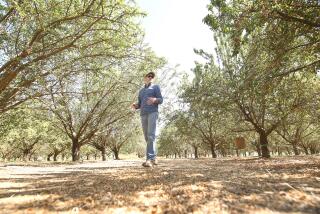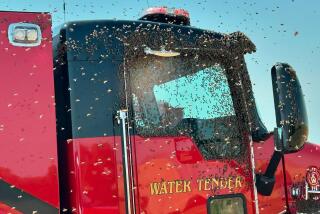Cross Breeding of Bees Expected to Blunt Peril : Berryhill Says Finding of Specialists Means That Aerial Spraying Should Be Unnecessary
BAKERSFIELD â A panel of bee specialists on Tuesday downgraded the threat to California agriculture from Africanized honeybees found in an underground hive in Central California, strongly suggesting that their ill-tempered characteristics will disappear as they mate with more docile domestic bees.
The unexpected finding was explained by the fact that the Africanized bees found in a single colony near the tiny community of Lost Hills northwest of here are far outnumbered by the European varieties kept in commercial hives throughout the area.
In releasing its findings, the advisory panel said that although swarms still in the area may have established colonies elsewhere, âit is highly improbable that there will be any long-term effect.â
âGenetic Dilutionâ
The large number of domestic bees in the immediate area, the panel added, âwill cause genetic dilution, leading to the elimination . . . (of) recognizable Africanized bee characteristics.â
The panel of scientists, convened to advise the state on how to deal with the discovery of so-called killer bees, called for the destruction of wild bee colonies within an expanded 7,850-square-mile area--everything within a 50-mile radius of the site where the colony was unearthed last month. They recommended, however, that wild bees be killed only as reports of their sightings within the area are received.
Meanwhile, the panel recommended that tests continue on commercial hives in a 400-square-mile quarantine area surrounding the discovery site. The tests are to determine whether the Africanized bees have taken up residence with the domestic variety.
Food and Agriculture Director Clare Berryhill, who is expected to make a final decision on the recommendations today, said there appears to be no need for aerial pesticide spraying or more drastic actions, such as destroying domestic beehives in the quarantine area. Berryhill and other Agriculture Department officials earlier held out such a mass destruction plan as a last resort.
âDepopulation of the whole area was considered,â Berryhill said. âBut in light of what we are hearing today (Tuesday), such action is not needed.â
The committeeâs surprise prediction that the genetic characteristics of the killer bees would disappear on their own was based on evidence unearthed from the beesâ underground hive in an oil field near Lost Hills.
Scientists said the hive, which had been active for about a year after being accidentally brought here in oil drilling equipment from South America, shows signs that the alien bees were being genetically diluted into more docile varieties by natural breeding.
âNo Tracesâ in a Year
Tom Rinderer, an advisory committee member and an expert in Africanized bees at the U.S. Department of Agriculture, predicted that there will be âno trace of the Africanized geneticsâ in bee colonies in the area within one year.
He added that state agriculture officials had overreacted in suggesting earlier that all bees in the area might have to be destroyed to stop the spread of the Africanized insects.
The Africanized bees, accidently introduced into the hemisphere in Brazil in 1959, are no more venomous than other varieties. Their ill-tempered characteristics, however, make them prone to attack in large numbers. They also pollinate fewer varieties of plants and produce less honey than domestic bees--characteristics that could threaten the multibillion-dollar agriculture industry in California and in other states if they become firmly established.
In South America, where the killer bees have been intermingling with other honeybee populations for 26 years, the hybrids reportedly are as fierce as the original African insects and have been blamed for as many as 150 human deaths.
Scientists on the stateâs science advisory committee said, however, that the Africanized bees are capable of displacing other varieties only when their numbers reach a âcritical massâ of several aggressive and well-established colonies. The insects took hold in South America after 26 queen bees and their swarms imported from their native Africa for a controlled breeding experiment escaped from a laboratory in Sao Paulo.
Signs of Change
In the case of the California discovery, scientists said, the single Africanized colony found near Lost Hills already had begun to show signs of genetic change before at least three queen bees left the nest with swarms of the insects.
Panel member Orley Taylor, a University of Kansas entomologist, said subtle changes were found in the size of individual cells in the honeycomb, indicating that the bees were purely Africanized when they arrived but that those produced later exhibited characteristics of the European variety bees that dominate commercial hives in the area.
âThis is evidence of the subsequent hybridization of the originally discovered colony with European bees,â Taylor said.
The panel also said that there is âa very low probabilityâ that parasitic mites often carried by Africanized bees had been introduced into the domestic bee colonies. Those mites are capable of wiping out whole colonies of domestic bees, but none were found in examinations of dead Africanized bees taken from the underground hive.
Some local beekeepers, however, appeared skeptical of the panelâs findings.
During an apiary advisory board meeting later Tuesday, one beekeeper, who refused to give his name, told the board that the state ought to quickly destroy all bees in the quarantine area and compensate the owners.
âGet It Over Withâ
âIf we find even one African, we ought to gas those suckers and get it over with,â he said.
The apiary board, which represents owners of 9,200 hives in the quarantine area, recommended that bees in 100% of the hives there be tested to see if there are any Africanized bees present. Science advisory committee members had indicated that it would be sufficient to sample only one hive in four.
The apiary board also recommended that the traps for wild bees be placed at one-mile intervals in the quarantine area.
Food and agriculture officials have found at least 12 nests of wild bees. All were to have been destroyed by Tuesday, and samples of the bees were to have been sent to laboratories. Officials indicated, however, that none of the wild bees found exhibited characteristics of Africanized bees.
One swarm of wild bees that chased Norman Gary, an entomologist at the University of California, Davis, for 200 yards after he disturbed their hive Monday was positively determined Tuesday to have been domestic European bees.
Wave of Bees Due
Meanwhile, scientists on the state advisory committee predicted that the wave of Africanized bees slowly migrating north from Brazil will reach the United States by 1988 or 1989 and enter California by 1990. They cautioned that although the single colony discovered in Central California is unlikely to become established, a serious threat is still posed by the natural northerly spread of Africanized bees.
Rinderer said scientists are busy drawing up contingency plans to help beekeepers fight off the Africanized bee invasion.
Aside from Rinderer, Taylor and Gary, members of the stateâs bee advisory panel are Steve Park, a commercial beekeeper from Palo Cedro, Calif., and Eric Mussen, an entomologist from the University of California, Davis.
Ronald B. Taylor reported from Bakersfield and Leo C. Wolinsky from Sacramento.
More to Read
Sign up for Essential California
The most important California stories and recommendations in your inbox every morning.
You may occasionally receive promotional content from the Los Angeles Times.










